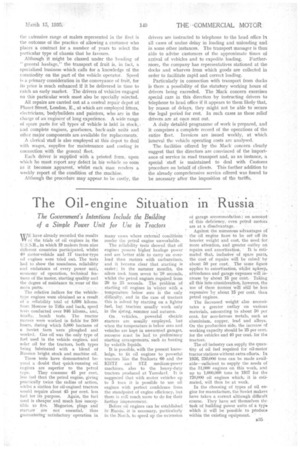The Oil-engine Situation in Russia
Page 49

If you've noticed an error in this article please click here to report it so we can fix it.
The Government's Intentions Include the Beading of a Simple Power Unit for Use in Tractors
WE have already recorded the results VV oi the trials of oil engines in the U.S.S.R., in which 19 makers from nine different countries participated, whilst 40 motor-vehicle and 17 tractor-type oil engines were tried out. The tests had to show the soundness, reliability and endurance of every power unit, economy of operation, technical features of the Motor, starting quality and the degree of resiStance to wear of the
ma i n parts.'
The relative indices for the vehicletype engines were obtained as a result of a reliability trial of 4,698 kiloms. from Moscow to Tiflis and back, speed tests conducted over 946 kilOres., and, finally, , bench tests. The tractor motors were worked in fields' for 500 hours, during Which 5,000 hectares of a Soviet farm 'were. ploughed and worked. Gas oil wa's the only type of fuel used in the vehicle engines, and solar oil for the tractors, both types being lubricated with a blend of Russian bright stock and machine oil.
These tests have demonstrated beyond a doubt that quick-running oil engines are superior to the petrol
type. They consume 45 per cent. less fuel than the petrol engine, giving practically twice the radius of action, whiiffi: a station for oil-engined tractors would require about 45 per cent. less fuel for its 1?.inpose. Again, the fuel used is cheaper and much lesS Susceptible te fire. Magnetos, plugs and starters' are not essential, thus gueranfeeing 'satisfactory operation in
many cases where external conditions render the petrol engine unworkable.
The reliability tests showed that oil engines possess higher' haulage power and are better able to carry an overload than motors with carburetters. 'and it became clear that starting is easier; in the summer months, the oilers took from seven to -10 seconds, whilst the petrol engines required. from 20 to 25 seconds. The, problein :of starting oil engines in Winter with a temperature below zero is the only difficulty, and in the case of tractors this is solved by starting on a lighter fuel, but tractors usually work only in the spring, summer and autumn.
On vehicles,'powerful • electric starters are usually emploYed, but when the temperature is below zero and vehicles are kept in unwarmed garages, recourse must be had to Preliminaty starting arrangements,' such as heating by volatile liquids.
It is possible, with the present knowledge, to fit oil engines to powerful tractors like the Stalinetz 60 and the KIITZ and STZ medium-power machines, also to the heavy-duty tractors produced at Yaroslavl. It is suggested that with motor vehicles up to 5 tons it is possible to use oil engines with perfect confidence from the standpoint of engine efficiency, but there is still much more to do for -their further improvement. Before oil engines can be established inRussia. it is necessary, particularly in the North, to speed up the extension
Of garage accommodation' on ace:QUO= of this 'deficiency, even petrel moters ;
are at a disadvantage... • . .
Against the numerous advantages of the Oil engine have to be sb.6 off its heavier. weight and cost, the need :for. more attention, and 'greater ontlay on repairs and amortization.It is estimated that, inclusive' of spare parts, the'cost of repairs win be raised r by about 50 per cent. The same -figure applies to aniortizatiorr, Whilst Upkeep, attendance and garage expenses will increase by about 15' per cent. Taking all this into chnsideration, ho'i'eVer, the Use-of these inOtOrS Will 'stiff -be less expensive by about 15 per cent than petrol engines.
The increased weightalso necessitates a greater outlay on various materials, amounting to about 50 per cent. for non-ferrous metals, such as aluminium, copper, lead and alloys. On the production side, the increase of working capacity should be 25 per cent. for the vehicles and 40 per cent. for the tractors.
The oil industry can supply the quantity of oil fuel required for oil-motor tractor stations without extra efforts. In 1936, 250,000 tons can be made available'-'-'sufficient to supply the needs of the 31;000 engines on this work, and up to 1,000,000 tons in 1937 for the 120,000 oil engines which, it is estimated, will then be at work.
In the choosing of types of oil engine for manufacture, the Soviet makers have taken a correct although difficult course. They have set themselves the task of building power units of a tyP4 Which it will be possible to produce) within the existing equipment.




























































































